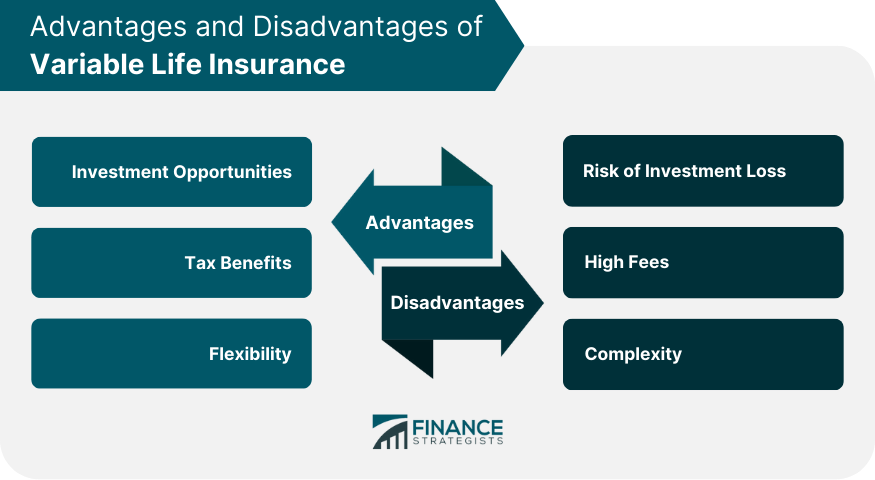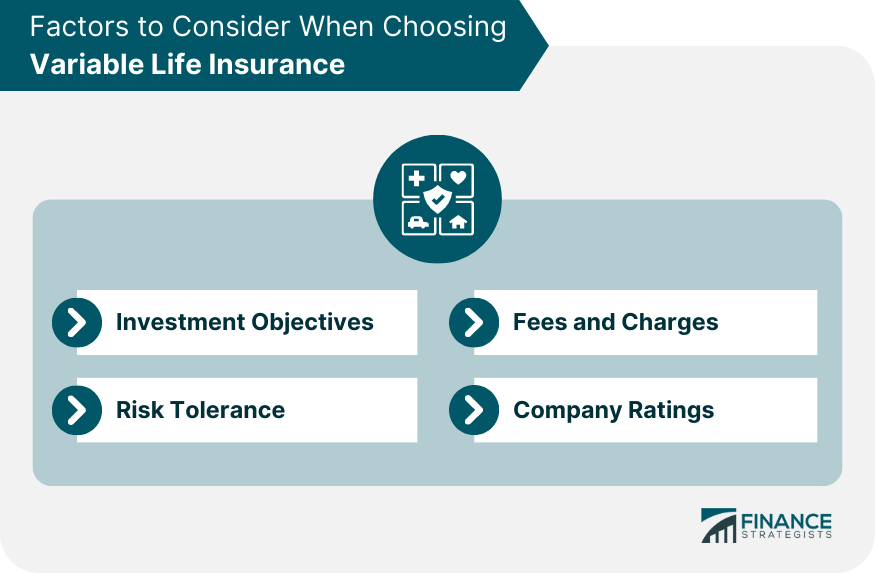Variable life insurance is a permanent life insurance policy with a cash value component that offers investment options. This type of policy allows the policyholder to invest the cash value in a variety of subaccounts, similar to mutual funds, with the potential for growth based on the performance of the underlying investments. Variable life insurance policies provide a death benefit to beneficiaries upon the insured's passing, and the cash value component offers the potential for investment growth during the insured's lifetime. The performance of the investments can impact both the cash value and the death benefit, offering both potential gains and risks to policyholders. The main purpose of variable life insurance is to provide financial protection for the insured's beneficiaries while offering the policyholder the opportunity to grow the policy's cash value through investments. This dual purpose can be attractive to those seeking life insurance coverage combined with the potential for investment growth. In addition to providing a death benefit, variable life insurance policies can serve as a long-term savings and investment vehicle. The cash value component can be used to supplement retirement income, pay for education expenses, or address other financial needs, depending on the performance of the chosen investments. In a variable life insurance policy, premium payments are divided into two parts. The first part goes towards the cost of insurance, which includes the death benefit, policy administration, and other fees. The second part is allocated to the cash value component of the policy. The premiums for variable life insurance policies can be flexible, allowing policyholders to adjust their payments based on their financial needs and objectives. Policyholders can choose to pay the minimum required premium to maintain the policy, or they can pay additional premiums to increase the cash value and the potential investment returns. The cash value component of a variable life insurance policy is an investment account that grows tax-deferred over time. Policyholders can allocate their cash value among a variety of investment options, depending on their investment objectives and risk tolerance. The performance of these investments directly impacts the growth of the cash value account. If the investments perform well, the cash value will increase, providing the policyholder with more potential funds for future use. Conversely, if the investments perform poorly, the cash value may decrease, which could affect the policy's death benefit and potentially require additional premium payments to maintain the policy. Variable life insurance policies offer a range of investment options for the policyholder to choose from, typically in the form of subaccounts that are similar to mutual funds. These investment options can include stocks, bonds, and money market funds, and they may be managed by professional investment managers. Policyholders can allocate their cash value among these investment options based on their risk tolerance, investment objectives, and time horizon. They also have the ability to change their investment allocations over time as their needs and objectives change. The death benefit in a variable life insurance policy is the amount paid to beneficiaries upon the insured's passing. The death benefit can be impacted by the performance of the policy's investments, with the potential to increase if the investments perform well or decrease if the investments perform poorly. However, most variable life insurance policies include a guaranteed minimum death benefit, which ensures that beneficiaries will receive a specified minimum amount regardless of the investment performance. This feature can provide peace of mind for policyholders, knowing that their loved ones will receive a certain level of financial protection upon their passing. One of the main advantages of variable life insurance is the potential for investment growth within the policy's cash value component. Policyholders have the opportunity to invest in a variety of subaccounts, which can provide the potential for increased cash value and higher death benefits. This feature can be especially attractive to individuals with a long-term investment horizon and a desire for greater control over their investments. Variable life insurance policies also offer tax-deferred growth, meaning that investment gains within the policy are not taxed until they are withdrawn. This can lead to a potentially larger cash value accumulation over time, as the investments can grow without being hindered by taxes. Variable life insurance policies offer several tax advantages, including tax-deferred growth of the cash value, tax-free loans and withdrawals from the cash value, and a tax-free death benefit for beneficiaries. These tax benefits can make variable life insurance an attractive option for individuals looking to minimize their tax liabilities while investing for the future. When policyholders withdraw funds from their cash value or take out loans against the policy, these transactions are generally not subject to income tax, as long as the policy remains in force. Additionally, the death benefit paid to beneficiaries upon the insured's passing is generally income tax-free, providing a significant tax advantage for the policyholder's loved ones. Variable life insurance policies offer a degree of flexibility that can be appealing to policyholders. Premium payments can be adjusted to fit the policyholder's financial needs and objectives, allowing for greater control over the policy's costs and benefits. Additionally, policyholders can change their investment allocations within the policy's cash value component as their needs and objectives change over time. This flexibility can be especially beneficial for individuals who want to actively manage their investments and adjust their strategy based on changing market conditions or personal financial goals. One of the primary disadvantages of variable life insurance is the risk associated with the policy's investment options. Because the cash value and death benefit are directly tied to the performance of the chosen investments, there is the potential for loss if the investments perform poorly. While some variable life insurance policies offer a guaranteed minimum death benefit, the cash value component may still be at risk. Policyholders should carefully consider their risk tolerance and investment objectives before choosing a variable life insurance policy. Variable life insurance policies often come with higher fees and expenses compared to other types of life insurance policies. These fees can include management fees for the investment subaccounts, policy administration fees, and sales charges or commissions. These higher fees can erode the policy's cash value and reduce the overall investment returns, making it crucial for policyholders to carefully evaluate the fees associated with a variable life insurance policy before purchasing. Variable life insurance policies can be more complex than other types of life insurance, due to the investment component and the associated risks and fees. This complexity may make it more challenging for policyholders to fully understand the policy and its potential outcomes, particularly for those with limited investment knowledge or experience. For this reason, it is essential for potential policyholders to work with a qualified financial professional who can help them navigate the complexities of variable life insurance and make informed decisions about their coverage and investment options. When choosing a variable life insurance policy, it is essential to consider your investment objectives and how the policy's investment options align with those objectives. This may include evaluating the available subaccounts, their historical performance, and the potential for growth based on your specific needs and goals. Your risk tolerance is another critical factor to consider when choosing a variable life insurance policy. Understanding your comfort level with investment risk can help you select a policy that offers the appropriate balance between potential growth and potential loss, ensuring that you are comfortable with the policy's investment options. Before purchasing a variable life insurance policy, carefully review the fees and charges associated with the policy. These may include management fees for the investment subaccounts, policy administration fees, and sales charges or commissions. High fees can erode the policy's cash value and reduce the overall investment returns, making it important to select a policy with competitive fees that align with your financial objectives. Finally, it is essential to consider the financial strength and reputation of the insurance company issuing the variable life insurance policy. This can help ensure that the company will be able to meet its financial obligations, including paying the death benefit when it becomes due. Independent rating agencies, such as A.M. Best, Standard & Poor's, and Moody's, provide ratings on the financial strength of insurance companies, which can be a helpful resource when evaluating potential policy providers. Variable life insurance can be a valuable financial tool for individuals seeking permanent life insurance coverage combined with the potential for investment growth. By understanding the policy's features, such as how the cash value and death benefit are impacted by the chosen investments, policyholders can make informed decisions about their coverage and investment options. However, variable life insurance also comes with inherent risks and complexities that must be carefully considered. By evaluating factors such as investment objectives, risk tolerance, fees and charges, and company ratings, potential policyholders can choose a variable life insurance policy that aligns with their financial goals and provides the appropriate level of protection for their loved ones. When choosing a variable life insurance policy, it is crucial to work with a qualified financial professional who can help navigate the complexities of this type of coverage and provide guidance on the most appropriate policy for your specific needs and objectives. What Is Variable Life Insurance?
Purpose of Variable Life Insurance
How Variable Life Insurance Works
Premium Payments
Cash Value Account
Investment Options
Death Benefit
Advantages of Variable Life Insurance
Investment Opportunities
Tax Benefits
Flexibility
Disadvantages of Variable Life Insurance
Risk of Investment Loss
High Fees
Complexity

Factors to Consider When Choosing Variable Life Insurance
Investment Objectives
Risk Tolerance
Fees and Charges
Company Ratings

Final Thoughts
Variable Life Insurance FAQs
Variable life insurance is a type of life insurance policy that allows you to invest part of your premium payments in various investment options.
Unlike traditional life insurance, variable life insurance policies have a cash value account that you can invest in different options, which may offer greater returns.
Variable life insurance policies offer investment opportunities, tax benefits, and flexibility in premium payments and death benefits.
Variable life insurance policies have higher fees, may have complex investment options, and carry the risk of investment loss.
Choosing the right life insurance policy depends on your investment goals, risk tolerance, and financial situation. It's important to research and compare different options before making a decision.
True Tamplin is a published author, public speaker, CEO of UpDigital, and founder of Finance Strategists.
True is a Certified Educator in Personal Finance (CEPF®), author of The Handy Financial Ratios Guide, a member of the Society for Advancing Business Editing and Writing, contributes to his financial education site, Finance Strategists, and has spoken to various financial communities such as the CFA Institute, as well as university students like his Alma mater, Biola University, where he received a bachelor of science in business and data analytics.
To learn more about True, visit his personal website or view his author profiles on Amazon, Nasdaq and Forbes.











